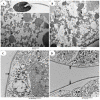Influences of DMP on the fertilization process and subsequent embryogenesis of abalone (Haliotis diversicolor supertexta) by gametes exposure
- PMID: 22028799
- PMCID: PMC3197592
- DOI: 10.1371/journal.pone.0025951
Influences of DMP on the fertilization process and subsequent embryogenesis of abalone (Haliotis diversicolor supertexta) by gametes exposure
Abstract
Di-methyl phthalate (DMP), a typical endocrine disrupting chemical (EDC), is ubiquitously distributed in aquatic environments; yet studies regarding its impact on gametes and the resulting effects on embryogenesis in marine gastropods are relatively scarce. In this study, the influences of DMP on the gametes and subsequent developmental process of abalone (Haliotis diversicolor supertexta, a representative marine benthic gastropod) were assessed. Newborn abalone eggs and sperm were exposed separately to different DMP concentrations (1, 10 or 100 ppb) for 60 min. At the end-point of exposure, the DMP-treated eggs and sperm were collected for analysis of their ultra-structures, ATPase activities and total lipid levels, and the fertilized gametes (embryos) were collected to monitor related reproductive parameters (fertilization rate, abnormal development rate and hatching success rate). Treatment with DMP did not significantly alter the structure or total lipid content of eggs at any of the doses tested. Hatching failures and morphological abnormalities were only observed with the highest dose of DMP (100 ppb). However, DMP exposure did suppress sperm ATPase activities and affect the morphological character of their mitochondria. DMP-treated sperm exhibited dose-dependent decreases in fertilization efficiency, morphogenesis and hatchability. Relatively obvious toxicological effects were observed when both sperm and eggs were exposed to DMP. Furthermore, RT-PCR results indicate that treatment of gametes with DMP changed the expression patterns of physiologically-regulated genes (cyp3a, 17β-HSD-11 and 17β-HSD-12) in subsequent embryogenesis. Taken together, this study proofed that pre-fertilization exposure of abalone eggs, sperm or both to DMP adversely affects the fertilization process and subsequent embryogenesis.
Conflict of interest statement
Figures









References
-
- Fent K. Ecotoxicological effects at contaminated sites. Toxicology. 2004;205:223–240. - PubMed
-
- Schwarzenbach RP, Escher BI, Fenner K, Hofstetter TB, Johnson CA, et al. The challenge of micropollutants in aquatic systems. Science. 2006;313:1072–1077. - PubMed
-
- Fatta-Kassinos D, Kalavrouziotis IK, Koukoulakis PH, Vasquez MI. The risks associated with wastewater reuse and xenobiotics in the agroecological environment. Sci Total Environ. 2011;409(19):3555–3563. - PubMed
-
- Zhou J, Cai ZH, Zhu XS. Are endocrine disruptors among the causes of the deterioration of aquatic biodiversity? Integra Environl Assess Manag. 2010;6(3):492–498. - PubMed
-
- Mackintosh CE, Maldonado JA, Ikonomou MG, Gobas FA. Sorption of phthalate esters and PCBs in a marine ecosystem. Environ Sci Technol. 2006;40:3481–3488. - PubMed
Publication types
MeSH terms
Substances
Associated data
- Actions
- Actions
- Actions
LinkOut - more resources
Full Text Sources

